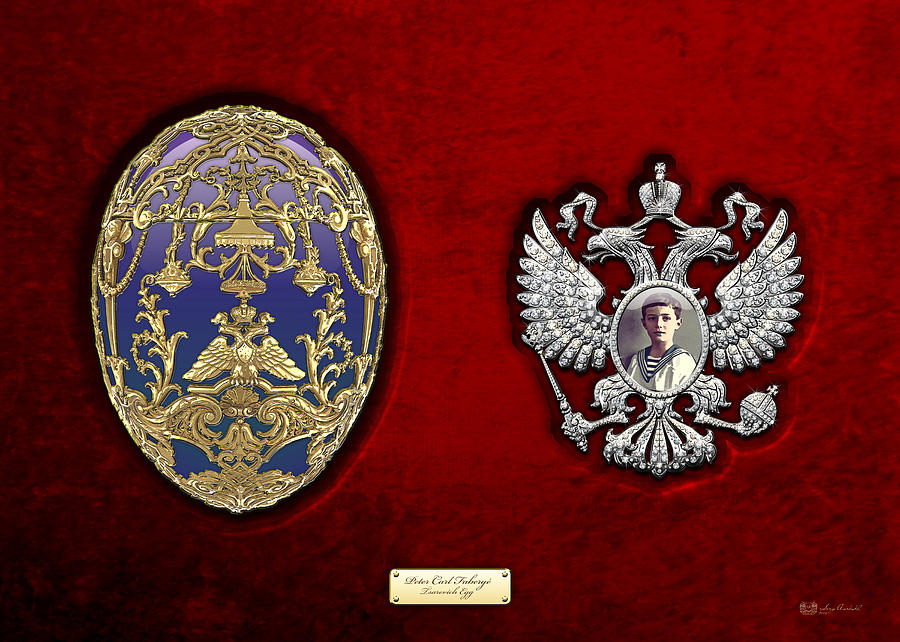
Faberge Tsarevich Egg With Surprise is a photograph by Serge Averbukh which was uploaded on May 12th, 2015.
Faberge Tsarevich Egg With Surprise
Introducing Treasure Trove 3D Collection by Serge Averbukh. Here you will find framed and wrapped/stretched canvas fine art prints, featuring one of... more
Title
Faberge Tsarevich Egg With Surprise
Artist
Serge Averbukh
Medium
Photograph - Instagram Photo
Description
Introducing "Treasure Trove 3D" Collection by Serge Averbukh. Here you will find framed and wrapped/stretched canvas fine art prints, featuring one of the Imperial Faberge Eggs - the Tsarevich Egg with Surprise on Red Velvet.
Peter Carl Faberge, also known as "Karl Gustavovich Faberge" (30 May 1846 - 24 September 1920), was a Russian jeweler, best known for the famous Faberge eggs, made in the style of genuine Easter eggs, but using precious metals and gemstones rather than more mundane materials. A Faberge egg is one of a limited number of jeweled eggs created by Peter Carl Faberge and his company from 1885 to 1917. The most famous of the eggs are the ones made for the Russian Tsars Alexander III and Nicholas II as Easter gifts for their wives and mothers, often called the 'Imperial' Faberge eggs. About 50 eggs were made, and 42 have survived. Another two were planned for Easter 1918, but because of the Russian Revolution were not delivered. After the Revolution, the Faberge family left Russia. The Faberge trademark has been sold several times since, and several companies have retailed egg-related merchandise using the Faberge name. The trademark is now owned by Faberge Limited, which makes egg-themed jewelry.
The Tsarevich Egg is a Faberge egg, one in a series of fifty-two jewelled eggs made under the supervision of Peter Carl Faberge. It was created in 1912 for Empress Alexandra Fyodorovna as a tribute by Faberge to her son the Tsarevich Alexis (Alexei). The egg currently resides in the Virginia Museum of Fine Arts. The egg is about five and three-quarters inches tall on its stand, with a diameter of four inches. The outer shell is blue lapis lazuli, with architectural, Louis XV-style gold cagework in a design of leafy scrolls. The gold motifs cover each joint, making the egg look as if it was carved from a single block of lapis. The goldwork includes two Imperial double-headed eagles, as well as cupids, canopies, floral scrolls, flower baskets and garlands. Two large diamonds, one at top and one at bottom, are encrusted into the egg's surface, showing the initials of Tsarina Alexandra Fyodorovna, the year 1912 and the Imperial crown. The location of the original stand is unknown, however it is thought to have not made it out of Russia when purchased by antiques dealer Armand Hammer.
The "surprise" inside is a Russian double-headed Imperial eagle with a miniature portrait of the Czarevich Alexis, set in platinum and encrusted with diamonds. The Imperial eagle holds the orb and sceptre representative of the Romanov crown jewels. The intricate frame sits on a lapis lazuli base and can be completely removed from inside the egg. The portrait portrays Alexei in his sailor suit, a favorite of the Tsarevich's. The original double-sided watercolor miniature portrait has suffered damage and is still in the collection of the Virginia Museum of Fine Arts. The current portrait on display is an archival photograph. Inside the egg, an engraved golden disc with a rose window design serves as a platform for the portrait frame.
Uploaded
May 12th, 2015
More from Serge Averbukh
Comments
There are no comments for Faberge Tsarevich Egg With Surprise. Click here to post the first comment.






















































